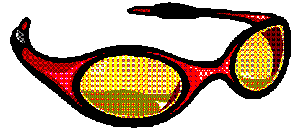
|
|

 Why we may need glasses!
Why we may need glasses!
Nearly everyone develops presbyobia some time during their 40s. This condition means in their loss of ability to focus on near objects. People with presbyobia need convex lenses for reading and for close work.
Some children develop strabismus, commonly called squint. In strabismus, the eyes look in opposite directions. To help correct this condition, glasses are needed to help the eyes look in the same direction. Without glasses, one eye may grow weaker and weaker!
A stigmatism results when light rays meet in two places in the eye, producing blurred images. Most often, this results when the cornea has an uneven shape. Spectacles can correct this condition.
Who prescribes glasses?
Glasses are prescribed after an eye examination made by an ophthalmologist or an optometrist. An ophthalmologist is a doctor who specialises in treating eye problems. An optometrist examines the eye, diagnoses problems and prescribes glasses.
How glasses work
As light rays enter the eye, they are refracted or bent. During part of the examination, called the refraction, the opthalmologist measures how much more or less each eye needs to refract light rays to focus them on the retina. The patient looks through different lenses, and an examiner then writes a prescription for those that provide the best vision.
So who invented spectacles? Around 1000 A.D.the reading stone, what we call the magnifying glass, was developed. It was a segment of a glass sphere that could be laid against reading material to magnify the letters. It enabled monks to read and was probably the first reading aid.
Sometimes, it is said that the Chinese developed the first glasses, but they apparently only used them to protect their eyes from an evil force!
One of the most significant developments in spectacle making was in the 16th Century, when concave lenses were introduced for the near sighted. Pope Leo X, who was very shortsighted, wore concave lenses when hunting and claimed that they helped him see better than his companions.
Spectacles continued to develop through to the twentieth century, and instead of avoiding wearing them in public - as was the case - people started to wear them as a fashion accessary! Sunglasses became very popular in the late '30's. The first contact lens was worn by a man who had his eyelid destroyed by cancer. The patient wore the lens until he died, without losing his vision.
Facts
 In the 1780s, Benjamen Franklin developed the bifocal and later wrote, "I therefore had formerly two pairs of spectacles, which I shifted occasionally, as in travelling I sometimes read, and often wanted to regard the prospects. Finding this change troublesome, and not always sufficiently ready, I had to wear my own spectacles constantly, I only have to move my eyes up or down, as I want to see distinctly far or near, the proper glasses being always ready".
In the 1780s, Benjamen Franklin developed the bifocal and later wrote, "I therefore had formerly two pairs of spectacles, which I shifted occasionally, as in travelling I sometimes read, and often wanted to regard the prospects. Finding this change troublesome, and not always sufficiently ready, I had to wear my own spectacles constantly, I only have to move my eyes up or down, as I want to see distinctly far or near, the proper glasses being always ready".![]() The grave of Salvana d'Atamento degli Amati a nobleman of Florence has statement that he invented spectacles, but kept the process a secret!
The grave of Salvana d'Atamento degli Amati a nobleman of Florence has statement that he invented spectacles, but kept the process a secret!![]() There was a big gap between the invention of the lens and the invention and use of spectacles. Why? The answer is the Church. Church teaching did not allow for man to alter what God had created!
There was a big gap between the invention of the lens and the invention and use of spectacles. Why? The answer is the Church. Church teaching did not allow for man to alter what God had created!